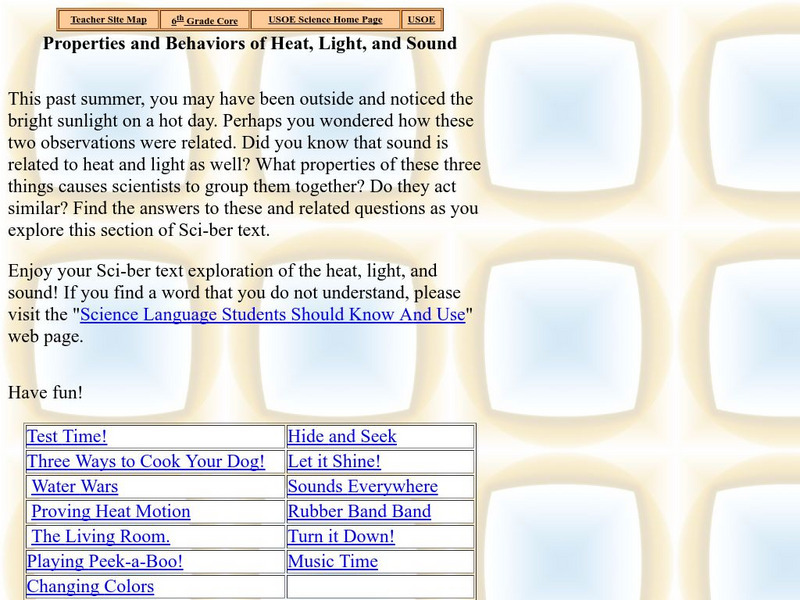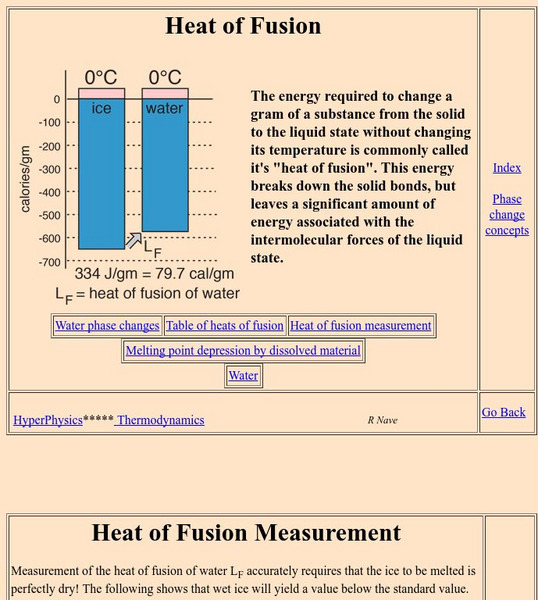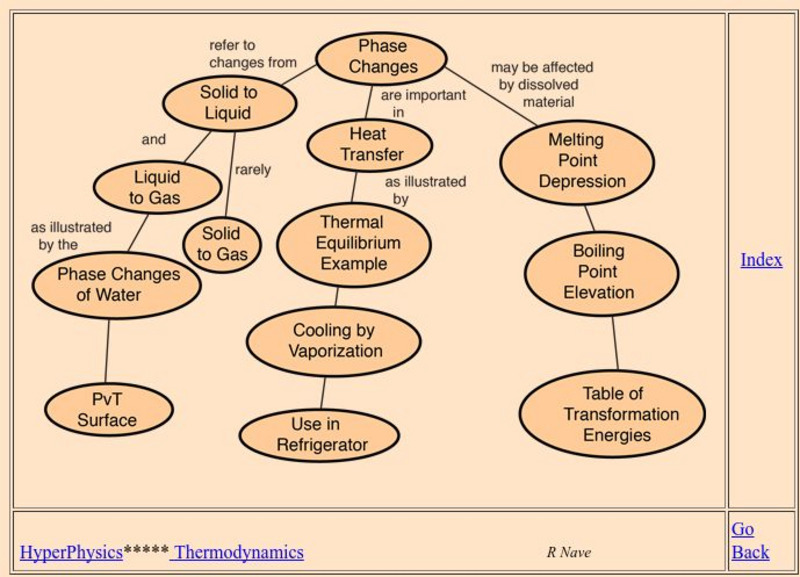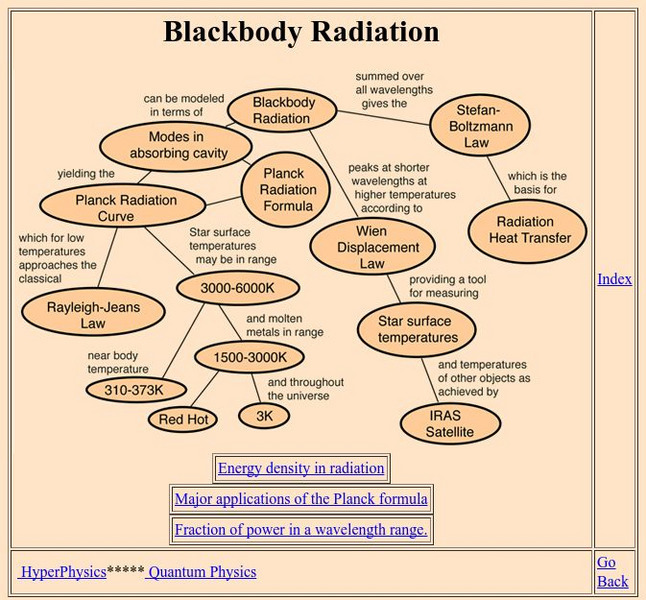CK-12 Foundation
Ck 12: Heat Transfer
[Free Registration/Login may be required to access all resource tools.] Students explore the relationship between heat and energy transfer, and learn about the three ways that heat can be transferred between objects of different...
Utah Education Network
Uen: Our Friend, the Sun
Understand the role of the sun as the source of heat and light for living things on earth.
Utah Education Network
Uen: Things Are Heating Up!
Heat is produced from mechanical and electrical machines and human activities.
Utah Education Network
Uen: Trb 4:1 Investigation 4 Heat Energy and Water
Learn how to differentiate between heat and temperature.
Utah Education Network
Uen: Trb 3:5 Investigation 1 Is It Hot in the Light?
Learn why things in direct sunlight are warmer than things that are not in as much sunlight.
CK-12 Foundation
Ck 12: Heat
[Free Registration/Login may be required to access all resource tools.] In this online lesson students will describe how the macroscopic properties of a thermodynamic system such as temperature, specific heat, and pressure are related to...
Utah State Office of Education
Utah Science: Properties and Behaviors of Heat, Light and Sound
How can scientists lump heat, light and sound together when investigating properties and behaviors? This learning module will address that question through a series of activities.
University of Illinois
University of Illinois Extension: Urban Programs Resource Network: Wind Chill & Heat Index
This animated resource helps the younger researcher understand wind chill and heat index.Charts of each are included as are the potential dangers.
Utah Education Network
Uen: Managing Heat
Understand the role of the sun as the source of heat and light for living things on earth.
Utah Education Network
Uen: Trb 3:5 Investigation 7 Rubbing Objects Together
Third graders will understand that heat may be produced when objects are rubbed together.
OpenSciEd
Open Sci Ed: 6.2 Thermal Energy
This Thermal Energy unit has students investigating two ways to transfer energy into a drink: (1) the absorption of light and (2) thermal energy from the warmer air around the drink. They are then challenged to design their own drink...
Concord Consortium
Concord Consortium: Greenhouse Effect in a Greenhouse
In this activity, you will use a temperature sensor to relate changes in sunlight to the temperature of the air trapped in a container.
Discovery Education
Discovery Education: 3 M Young Scientist Lab: Too Hot to Handle
Can you design a handle for Hot Stuff's new skillet?
Concord Consortium
Concord Consortium: Stem Resources: Greenhouse Effect in a Greenhouse
A lab where students will construct their own small greenhouse out of a plastic container, plastic wrap, and different materials to observe the effect this has on temperature. Data is collected, graphed, and saved online to be graded by...
Florida State University
Florida State University: Intermolecular Forces: Changes of State
Discusses the changes of state that can occur for the three different types of matter (solids, liquids, and gases) and different types of heat energy that have been defined by scientists.
Georgia State University
Georgia State University: Hyper Physics: Heat Flow to Hotter Region
Heat flow from a hot region to a cold region is described and explained. Applications of this phenomenon (specifically heat pumps and refrigerators) are discussed. Excellent graphics.
Georgia State University
Georgia State University: Hyper Physics: Heat Engine Concepts: Carnot Cycle
The Carnot cycle is described, illustrated and explained. The Carnot efficiency equation is given and interactive JavaScript form allows the visitor to investigate the effect of the reservoir temperature and the sink temperature upon the...
Georgia State University
Georgia State University: Hyper Physics: Law Concepts
This site from Georgia State University Department of Physics and Astronomy is an indexing page for the HyperPhysics site. The page links to a variety of other pages which discuss concepts related to entropy and the second law of...
Georgia State University
Georgia State University: Hyper Physics: First Law of Thermodynamics
At this site from Georgia State University the first law of thermodynamics is stated and explained. The meaning of internal energy and enthalpy is discussed. Equations are given and the importance of a system analysis is discussed.
Georgia State University
Georgia State University: Hyper Physics: Zeroth Law of Thermodynamics
The principle of thermal equilibrium is discussed and explained. The zeroth law of thermodynamics is stated. Links to several other pages with related information are provided.
Georgia State University
Georgia State University: Hyper Physics: Heat of Vaporization
A discussion of the vaporization process and the energy changes which accompany the process. Includes an informative graphic and a discussion of how to determine the heat of vaporization.
Georgia State University
Georgia State University: Hyper Physics: Phase Change Concepts
An indexing page for the HyperPhysics site. This page includes links to a variety of pages at the site which contain information related to phase changes. Each individual page consists of informative graphics and clear explanations.
Georgia State University
Georgia State University: Hyper Physics: Heat Engine Cycle
The heat engine cycle is defined and discussed. So pressure-volume diagrams are introduced and their use in depicting the cycles of a heat engine is demonstrated. Informative graphics are accompanied by reason-filled explanations.
Georgia State University
Georgia State University: Hyper Physics: Blackbody Radiation
An indexing page for the HyperPhysics site. This page includes a concept map of links to pages that contain information related to blackbody radiation. Each individual page consists of informative graphics and clear explanations.


















